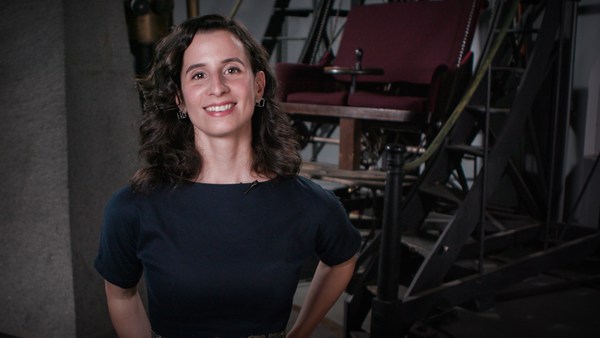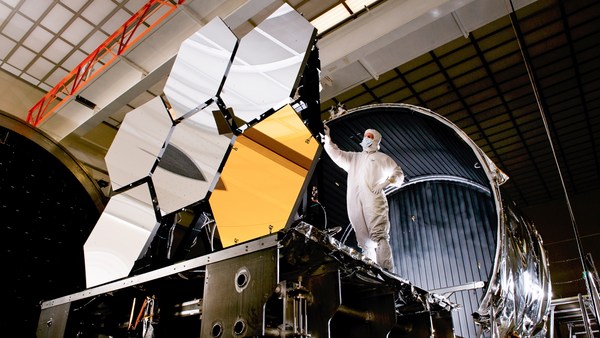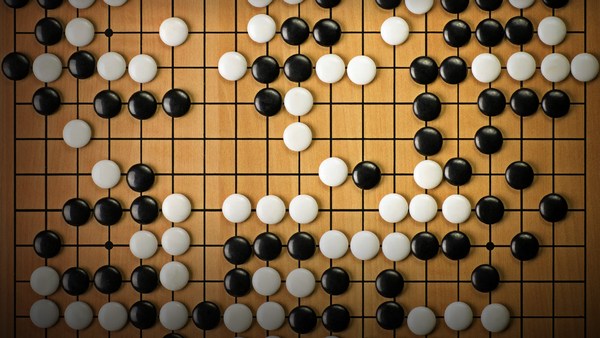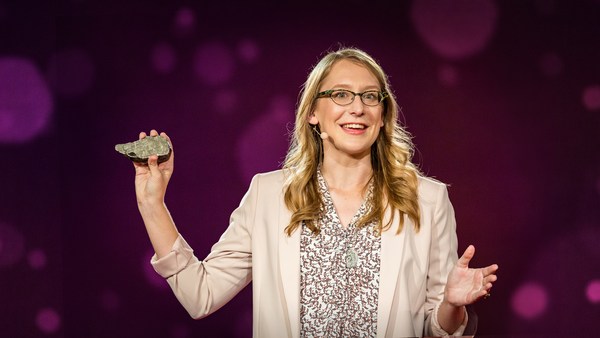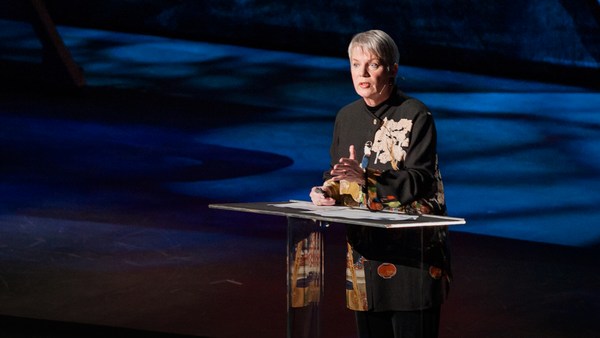When I look up at the sky at night, I see 100 billion stars of the Milky Way galaxy. They look like lights in cabins of a giant spaceship, The Milky Way, sailing through space. And I wonder if there are other passengers in those cabins. There are 100 billion of them, comparable to the number of people who ever lived on Earth.
It would be arrogant to think otherwise, that we are alone, that we are unique and special, especially if you read the news every day. We are not the pinnacle of creation. There is room for improvement.
(Laughter)
I'm just a curious farm boy, and I wonder about the world around me. And I hate to behave like the adults in the room, because they often pretend to know more than we actually know. And that bothered me since I was a young kid. And so I decided to become a scientist and answer the questions based on evidence, not based on prejudice, not based on the politics of getting the largest number of likes on social media. I don't have a footprint on social media. I enjoy nature. Whatever it brings to our doorstep is welcome. So let's just look around.
And for 70 years, we've been searching for radio signals. This is equivalent to staying at home and waiting for a phone call that may never come because nobody cares that we are lonely. It may also be that others are addicted to digital screens and they live in a virtual reality, as we are at this point in time.
A much better approach is to check if there is any object in our backyard that may have arrived from a neighbor's yard. Like a tennis ball, that may tell us that the neighbor plays tennis. And we haven't really checked until the last decade.
The first object to have been reported by astronomers that came from outside the solar system looked really weird. It was discovered by a telescope in Hawaii. When it passed close to Earth, it was the size of a football field. What you see behind me is the artist's depiction. It looked really weird because as it was tumbling every eight hours, the amount of sunlight reflected from it changed by a factor of ten, which meant that it has a very extreme shape, most likely flat, like a pancake.
And moreover, it exhibited a push away from the sun by some mysterious force because there was no evaporation, no cometary tail around it, no dust, no gas. So the question was, what is pushing it? And I suggested that maybe it's the reflection of sunlight, but for that, the object had to be very thin, like a sail. And that meant that it was not produced naturally. Maybe it's a surface layer, maybe it's space trash, like a plastic bag tumbling in the wind.
And so we go back 70 years to a question that Enrico Fermi, the physicist, asked at Los Alamos, "Where is everybody?" Well, this is a question that single people often ask. But if you stay at home --
(Laughter)
You will not find anyone. You have to go to dating sites. At the very least, you need to look through your windows for other people. And he didn't seek the evidence. He was just asking the question and kept repeating it. And if we don't look for evidence, we will not find anything. It's a self-fulfilling prophecy. It's a way to maintain our ignorance. And science is better than politics. We can find the evidence if we allocate the funds for it.
This is a real image, what you see behind me, it's the Tesla Roadster car that was put as a dummy payload on the Falcon Heavy launch of 2018. It's now moving in an elliptical orbit around the Sun, and perhaps in 20 million years, it will collide with Earth. And if it will do so unexpectedly, some of my colleagues would argue "This is a rock of a type that we've never seen before."
(Laughter)
We cannot see it with our best telescopes because it's too small. It doesn't reflect enough sunlight. 'Oumuamua was the size of a football field, big enough for us to see.
And so the next Copernican revolution would be that we are not at the intellectual center of the universe. Not only that we are not at the physical center of the universe, but actually, you know, we arrive to the play relatively late. We are not at the center of stage. The play is not about us. We should be modest. We keep thinking that it's about us, but it's not. And we better find other actors that will tell us what the play is about.
And people often say extraordinary claims require extraordinary evidence, but they are not seeking the evidence. Actually, extraordinary evidence requires extraordinary funding.
(Laughter)
(Applause)
Elon Musk argued recently, "I don't see any aliens." But new scientific knowledge does not fall into our lap. We had to invest 10 billion dollars in the Large Hadron Collider in order to find the Higgs boson. We had to invest 10 billion dollars in the Webb telescope in order to find the first generation of galaxies. This is the way science is done. You need to put the effort in order to find something new.
And only over the past decade, we discovered objects that came from outside the solar system. The first one was actually a decade ago. It was a meteor, an object half a meter in size that collided with Earth and burned up in the atmosphere. It was spotted by US government satellites. The fireball that it generated released a few percent of the Hiroshima atomic bomb energy, and it was moving too fast to be bound to the Sun's gravity.
And so we concluded it's interstellar. It came from outside the solar system. Could it be a Voyager-like meteor? Imagine our own spacecraft colliding with a planet like Earth. In the future, it would appear as a meteor of unusual material strength and unusual speed, which are exactly the properties of this meteor from 2014.
And then 'Oumuamua was discovered in 2017, and finally a comet appeared, also from interstellar space, was moving too fast. And so my colleagues argued, "Well, this one looks familiar. Doesn't it convince you that the others are natural in origin? Rocks of a type that we've never seen before?"
And I say, if I go down the street and I see a weird person, and after that I see a normal person, it doesn't make the weird person normal.
(Laughter)
Now the US --
(Laughter)
Director of National intelligence --
(Applause)
Avril Haines delivered three reports to the US Congress, talking about unidentified anomalous phenomena. The good news is the sky is not classified. We don't need to wait for the US government to tell us what lies outside the solar system. Their day job is national security. My day job is figuring out what lies beyond the solar system. And the sky is not classified. We can answer the question ourselves.
So I'm leading the Galileo project. We built an observatory at Harvard University that monitors the sky 24/7, looking for objects that are not familiar, not birds, balloons, drones, airplanes, satellites. So far, we monitored half a million objects. Haven't found anything unusual yet, but we keep looking and we are using machine-learning software to figure out what we are looking at.
But the most exciting endeavor that I was involved in is an expedition to the Pacific Ocean near Papua New Guinea, to look for the materials from this meteor that I described before. And the US Space Command issued a letter to NASA confirming at the 99.999 percent that this object indeed originated from outside the solar system. Based on its high speed, it was moving faster than 95 percent of all stars in the vicinity of the Sun. It exploded in the lower atmosphere, about 90 kilometers away from Manus Island in Papua New Guinea, and that meant that the object had material strength tougher than even iron meteorites.
And so I led an expedition in June 2023. You can see the team on the ship that was fittingly called Silver Star, and we used the sled with magnets on both sides to search for droplets left over from the explosion of this meteor. And at the bottom left you see the filming crew of Netflix. They are preparing a documentary about this research, and the director asked me, "Avi, it looks like you are running," because I was jogging at sunrise, as I often do on land for a few miles. And he said, "Are you running away from something or towards something?" And I said, "Both. I'm running away from some of my colleagues who have strong opinions without seeking evidence, and I'm running towards a higher intelligence in interstellar space."
Now we used this sled and collected magnetic particles from the ocean floor about a mile deep. And then I brought them to my colleagues at Harvard University. They look like metallic spheres, very distinct from the background of sand in which they were collected. And my colleague at Harvard, Stein Jacobsen, is a world-renowned geochemist. He used the electron microprobe, a mass spectrometer, in his laboratory. The person on the other side of me in this picture is a summer intern, Sophie Bergstrom, who found most of our molten droplets. And so I called her the spheral hunter.
And most of our spherules were actually of a type familiar from the solar system, but about 10 percent of them looked unusual, and they had a chemical composition very different from solar system materials. They had abundances of elements like beryllium, lanthanum, uranium, that are up to a factor of 1,000 more than found in solar system materials. They were not from the Earth, not from the moon, not from Mars, not from asteroids.
And so now the question arises, was this a rock from another star? And of course, one possibility is that there was a natural process that produced it. For example, most stars are dwarf stars, 10 percent of the mass of the sun, and they are 100 times denser than the sun. And so if you bring a planet like the Earth close to them, they spaghettify the planet, make a stream of rocks that could be ejected at a speed similar to that of this meteor.
But it's also possible that this object was of artificial origin, in which case, if we look for bigger pieces of the object, we might find a gadget with buttons on it. And I asked students in my class, "If we find such a gadget, should we press a button?"
(Laughter)
Now, some of my critics argued, maybe it's coal ash. So we looked at 55 elements from the periodic table and found that the abundances of elements are very different from coal ash. So it's not coal ash. Others argued, "Maybe it was not a meteor, maybe it was a truck." Well, the data came from US government satellites. We actually based our search region on the Department of Defense coordinates, and we went 26 times back and forth, searching that region.
So the next expedition, hopefully within the year, will search for bigger pieces of the object, maybe even the core of the object, because that could have a huge impact on humanity. We all know the biblical story about Moses, who looked at the bush that was burning without being consumed, with religious awe, and that gave Moses the sense that there is a superhuman entity, God, out there.
Now, Friedrich Nietzsche in 1882 argued, "God is dead." And that gave rise to the modern period of science and technology, where humans have this hubris, they lack modesty. Nobody is smarter than us, we are at the top of the food chain. Maybe AI will do a little better. But AI is just a digital mirror. It reflects our faults. It's nothing better than us. It's not a digital species. It's just us.
(Applause)
And if we find a partner out there, of course, that will give a new meaning to our existence. And it's a whole different ball game. Something from another star has nothing to do with us. And we better be ready for that. Not look at the mirror and imagine something like it, as science fiction stories do.
Now the good news is, next year, the Rubin Observatory in Chile will survey the southern sky every four days with a camera that is the size of a person, 3.2 billion pixels, a thousand times more than your cell phone camera. And so if we find more objects like 'Oumuamua, it might give us a sense of modesty. We might bring back this sense of awe that Moses had. Except in this time, it will be based on something that was delivered from interstellar space, from a neighbor.
And that is quite promising, actually, because it may change our priorities. Instead of spending four trillion dollars a year on military budgets, killing each other for territories on this rock, the tiny rock, left over from the formation of the sun, we might realize that there is a smarter kid on the block, and that kid may provide a better role model than our politicians.
(Applause)
And if we allocate four trillion dollars a year to space exploration, we could send a CubeSat towards every star in the Milky Way galaxy, hundreds of billions of them, within one century. And it gets better than that, because if we find a superhuman intelligence out there ... We might learn new physics. The first question I would ask is, "What happened before the Big Bang?" And they might have quantum gravity engineers that are capable of creating a baby universe in the laboratory. And this job of creating a new universe can be perfected. And that would help us actually,
(Laughter)
given that there is a lot of room for improvement in the world that we inhabit.
Thank you.
Chris Anderson: Thank you, Avi.
(Applause)
I’m here like a visitor from another planet, because we’re out of time. But also just to ask you one yes or no question, OK? If you had to put money on it, in the next ten years, what do you think -- is it likely that we will discover convincing evidence that persuades a critical mass of your colleagues that there is someone out there. And I just want a yes or no.
Avi Loeb: Yes.
CA: Yes! Avi Loeb!
(Applause)
